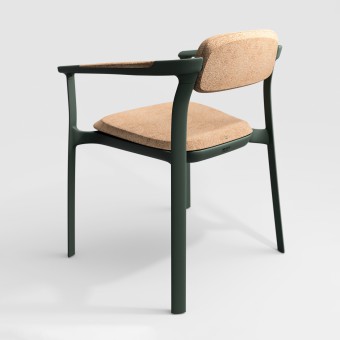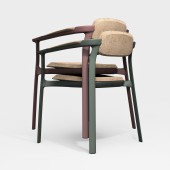Move Chair by Ariel Sliwinski |
Home > Winners > #156196 |
 |
|
||||
| DESIGN DETAILS | |||||
| DESIGN NAME: Move PRIMARY FUNCTION: Chair INSPIRATION: The primary goal of the project was to create a form in line with the principles of Juhani Pallasmaa. The aim was to provide the user with not only visual but also tactile experiences. The use of materials differing in texture, hardness, and temperature within a single piece of furniture allowed for a design that is intriguing not only visually but also haptically. A crucial aspect of the project was to achieve a form based on material contrasts. UNIQUE PROPERTIES / PROJECT DESCRIPTION: The chair has ability to adjust to individual needs, and body shape. To achieve the best ergonomics, a seat was employed that, like a cradle, can change its tilt angle. The backrest, on the other hand, suspended at two converging points along the axis, has the ability to rotate and tilt. An additionally designed element is an embedded pressure sensor in the seat. After a specified period, it automatically reminds the user to stand up through vibrations, promoting a healthier sitting routine. OPERATION / FLOW / INTERACTION: This project is oriented towards the user on multiple levels. Firstly, the organic form, diverse in terms of touch, aims to also appeal to the sense of touch, thereby enhancing the user's connection with the product. On the other hand, movable elements allow the furniture to be adapted to individual ergonomic needs. Its construction has been designed so that the furniture can be easily assembled by the user. PROJECT DURATION AND LOCATION: the project started in April 2023 in Poland FITS BEST INTO CATEGORY: Furniture Design |
PRODUCTION / REALIZATION TECHNOLOGY: The chair's structure was designed with cast aluminum elements, providing both lightness and rigidity, while the seat, backrest, and armrests were crafted from five-axis milled cork. SPECIFICATIONS / TECHNICAL PROPERTIES: 550mm x 515mm x 740mm TAGS: ergonomic chair, cork, aluminum, haptic, stackable, health sitting routine, rotating backrest, RESEARCH ABSTRACT: During several years of working in the furniture industry, I came to the conclusion that there is no such thing as the perfect chair, mainly because each of us is unique and has different needs. In the context of the prevailing global overconsumption, I asked myself whether it makes any sense to design another chair, and if so, what characteristics it should have. In response, a project was created that attempts to reconcile ergonomics, functionality, high quality, and above all, ecology. The main challenge was to create a piece of furniture with a reduced environmental impact and one that would bring a new level of quality to the furniture market. CHALLENGE: In the material selection and construction phase, environmental considerations played a significant role in the project. The aluminum used in designing the chair's structure is a material composed entirely of recycled content. The cork, employed for the remaining elements, is a natural material that can also be recycled. The chair's design was developed to be easily assembled by the user, allowing it to be shipped in flat boxes, thereby reducing its carbon footprint. Furthermore, all components share the same material, facilitating the option to repair or replace worn elements, promoting sustainability throughout the chair's lifecycle. ADDED DATE: 2023-12-10 10:05:27 TEAM MEMBERS (1) : IMAGE CREDITS: Ariel Sliwinski, 2023. |
||||
| Visit the following page to learn more: https://www.arielsliwinskistudio.pl/ | |||||
| AWARD DETAILS | |
 |
Move Chair by Ariel Sliwinski is Winner in Furniture Design Category, 2023 - 2024.· Press Members: Login or Register to request an exclusive interview with Ariel Sliwinski. · Click here to register inorder to view the profile and other works by Ariel Sliwinski. |
| SOCIAL |
| + Add to Likes / Favorites | Send to My Email | Comment | Testimonials | View Press-Release | Press Kit |







